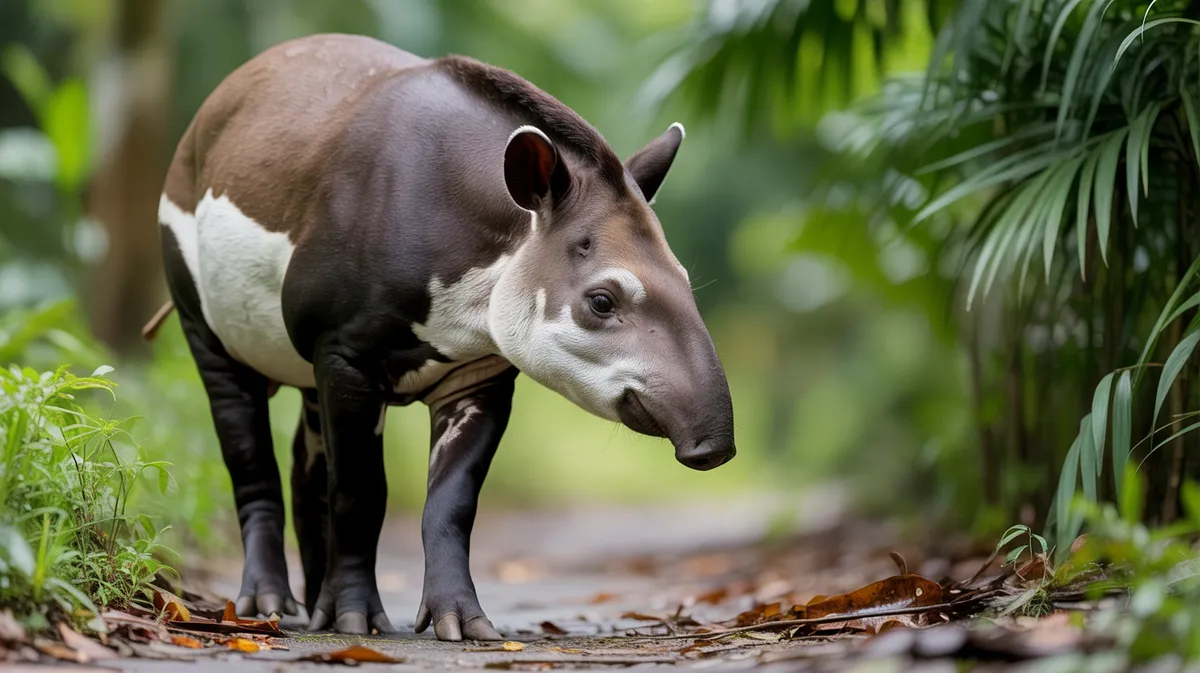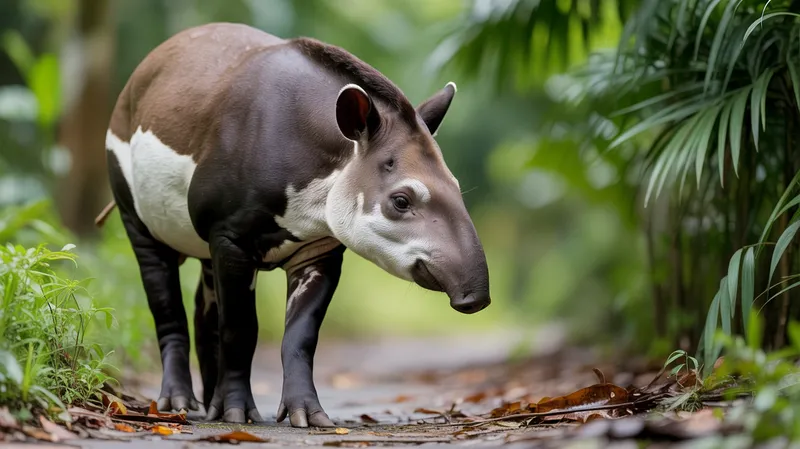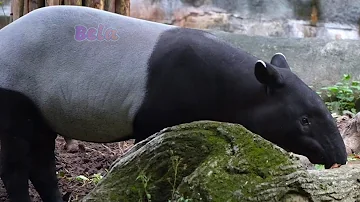
Brazilian Tapir
Tapirus terrestris

Meet the Brazilian Tapir
The Brazilian Tapir, also known as the South American Tapir or lowland tapir, is the largest terrestrial mammal in South America. It has a robust, barrel-shaped body, short legs, and a distinctive prehensile snout that it uses for grasping leaves and fruit. Brazilian Tapirs are mostly nocturnal and are excellent swimmers, often taking to water to escape predators or cool off. They play an essential role in their ecosystem as seed dispersers, helping to maintain forest diversity.
Classification
Mammal
Habitat
Rainforest
Diet
Herbivore
Lifespan
25–30 years
Conservation
Vulnerable
Weight
150–250 kg
📖Fascinating Facts
Forest Gardeners
Brazilian Tapirs help shape their environment by eating fruits and dispersing seeds throughout the rainforest.
Expert Swimmers
They are highly skilled in water, using rivers and lakes to travel, feed on aquatic plants, and evade predators.
Spotted Calves
Tapir calves are born with white stripes and spots, which provide camouflage in the dappled forest light.
📋Detailed Description
The Brazilian Tapir (Tapirus terrestris) is a large, robust perissodactyl mammal, typically weighing between 150 and 250 kg (330–550 lbs), with some individuals exceeding 300 kg. Adults measure 1.8 to 2.5 meters in length and stand about 77–108 cm at the shoulder. Their thick, tough skin is dark brown to gray, providing protection against predators and dense undergrowth. The most distinctive feature is the flexible, prehensile proboscis, formed by the upper lip and nose, which is highly sensitive and used to grasp foliage, fruit, and aquatic plants. Tapirs have small, rounded ears and a short, bristly mane running down the neck. They are primarily solitary, exhibiting crepuscular and nocturnal activity patterns, although some diurnal activity is observed in undisturbed areas. Tapirs are excellent swimmers and often wallow in mud or water, which helps regulate body temperature and remove parasites. Their large, splayed feet with three functional toes on each hind foot and four on each front foot aid in traversing muddy or soft terrain. The species is long-lived, with wild individuals reaching 25–30 years. Tapirs play a critical ecological role as mega-herbivores and seed dispersers, influencing forest regeneration and plant community dynamics.
💡 Did you know?
Despite their pig-like appearance, tapirs are more closely related to horses and rhinoceroses than to pigs.
🔬Research & Sources
Wikipedia Summary
The South American tapir, also commonly called the Brazilian tapir, the Amazonian tapir, the maned tapir, the lowland tapir, anta, and la sachavaca, is one of the four recognized species in the tapir family. It is the largest surviving native terrestrial mammal in the Amazon.
Last Modified: 5/25/2025
🎭Behavior & Social Structure
Brazilian Tapirs are predominantly solitary, with individuals maintaining overlapping home ranges that can span 2–8 km² depending on habitat quality. They are highly territorial, using urine, feces, and scent glands on their feet to mark trails and communicate presence. Tapirs are primarily nocturnal and crepuscular, foraging during the cooler hours of dusk, night, and dawn. Their diet consists of over 200 plant species, including leaves, twigs, fruits, seeds, and aquatic vegetation, with a preference for young, tender shoots and seasonal fruits. Tapirs use their prehensile snout to pluck food and can stand on their hind legs to reach higher branches. They are known for their excellent swimming ability, often crossing rivers or submerging themselves to escape predators such as jaguars, pumas, and caimans. Tapirs communicate through high-pitched whistles, squeals, and snorts, especially during mating or when alarmed. Despite their size, they are generally shy and elusive, relying on dense vegetation for cover.
👶Reproduction & Life Cycle
The reproductive cycle of the Brazilian Tapir is characterized by a polygynous system, with males seeking out receptive females during the breeding season, which varies regionally but often coincides with the rainy season (October to April in much of the Amazon). Courtship involves vocalizations, scent marking, and mutual sniffing. After mating, the gestation period lasts approximately 13 months (about 390–400 days), resulting in the birth of a single calf, although twins are extremely rare. Newborn calves weigh 6–9 kg and are distinguished by their reddish-brown coats with white stripes and spots, providing camouflage in dappled forest light. This cryptic coloration fades after 6–8 months. Calves are precocial, able to stand and follow their mother within hours of birth. Maternal care is intensive, with the mother providing protection and guidance for up to 12–18 months, after which the young become independent. Sexual maturity is reached at 3–4 years of age.
🛡️Adaptations & Survival
Tapirus terrestris exhibits several adaptations for survival in dense tropical forests and wetlands. Its prehensile snout is a key evolutionary specialization, enabling precise manipulation of food and exploration of the environment. The tapir's thick, tough skin, especially on the rump, offers protection from predators and thorny vegetation. Their splayed toes and flexible feet distribute weight effectively, preventing sinking in soft mud and facilitating movement through marshy terrain. Tapirs have acute hearing and a well-developed sense of smell, compensating for relatively poor eyesight. Their ability to swim and dive allows them to exploit aquatic habitats for food and refuge. Behavioral adaptations include nocturnality to avoid heat stress and predation, and the use of established trails (tapir paths) through the forest, which also benefit other wildlife.
📚Research Sources
🎨Cultural Significance
Tapirs hold significant cultural value in many South American indigenous communities, where they are often featured in folklore and traditional stories as symbols of strength, fertility, and connection to the forest. In Amazonian mythology, tapirs are sometimes regarded as guardians of the forest or as animals with supernatural abilities. The species is known by various local names, such as 'anta' in Brazil and 'sachavaca' in Peru. Historically, tapirs have been hunted for their meat and hide, but they are also respected for their ecological role. Conservation programs increasingly incorporate traditional ecological knowledge and local beliefs to promote coexistence and stewardship.
🔬Recent Research & Discoveries
Recent research on Tapirus terrestris has focused on its ecological role as a keystone seed disperser, with studies demonstrating its importance for the regeneration of large-seeded tree species. GPS telemetry and camera trap studies have provided new insights into tapir movement patterns, habitat use, and responses to habitat fragmentation. Genetic studies have revealed significant population structure across the species' range, highlighting the need for region-specific conservation strategies. Ongoing research is investigating the impact of climate change on tapir habitats and the potential for disease transmission between tapirs and domestic livestock. Conservation genetics, reproductive biology, and the development of non-invasive monitoring techniques are active areas of study.
🎥Wildlife Videos

The Unique Wildlife of Brazil’s Rainforest
Explore the incredible biodiversity and unique ecosystems of Brazil's Mata Atlântica and other regions. The show delves into the ...
Real Wild

🐗 The Brazilian Tapir – The Jungle’s Gentle Giant! 🌿🔥
The Brazilian Tapir – The Jungle's Gentle Giant! Meet the Brazilian Tapir, one of the Amazon Rainforest's most unique ...
Ases World

Tapir in the forest - Animals Documentary Videos
Tapirs are big, herbivorous animals that are members of the Tapiridae family. With a short, prehensile nose trunk (proboscis), they ...
Bela

Why Tapirs Love Spending So Much Time Underwater
Tapirs love to dive into the water, where they'll use their snout as a snorkel. There, they can evade jaguars, eat aquatic plants and ...
Smithsonian Channel

Brazilian Tapir: The Giants of the Rainforest
In today's video, we're diving into the world of the Brazilian Tapir, the gentle giants of the rainforest! These incredible ...
The Story of Animals

True Facts About The Tapir
Film Footage courtesy of Shutterstock, Inc., Used by Permission.
Ze Frank
🌍Habitat Information
The Brazilian Tapir typically inhabits Rainforest environments. Brazilian Tapirs have adapted to their environments with specialized features and behaviors.
Primary Habitat:
Rainforest
More detailed habitat information will be available soon.
🛡️Conservation Status
The Brazilian Tapir is currently classified as Vulnerable. Conservation efforts are crucial for preserving this species for future generations.
Common Threats:
- 🏠Habitat loss and fragmentation
- 🌡️Climate change impacts
- 🎯Hunting and poaching
- 🏭Human-wildlife conflict
⚠️Threats & Conservation Challenges
The Brazilian Tapir faces a range of threats, primarily habitat loss and fragmentation due to deforestation for agriculture, cattle ranching, and infrastructure development. Illegal hunting for meat and hide, as well as accidental deaths from road collisions, further impact populations. The species is particularly vulnerable to habitat fragmentation, as it requires large, contiguous tracts of forest to maintain viable populations. Tapirs are slow breeders, with low reproductive rates, making population recovery difficult. Emerging threats include disease transmission from livestock and climate change, which may alter habitat suitability and food availability. According to the IUCN Red List, populations are declining, and the species is classified as Vulnerable. Conservation efforts focus on habitat protection, wildlife corridors, anti-poaching measures, and community engagement.
🔬Scientific Classification
Scientific Name
Tapirus terrestris
Classification Hierarchy
🔍 About Taxonomic Classification
Taxonomic classification is a hierarchical system used by scientists to classify and organize living organisms based on shared characteristics and evolutionary relationships.
The system moves from broad categories (Kingdom) to increasingly specific ones, with each animal's scientific name typically consisting of its Genus and species.
📝Community Notes
Share your observations and insights about the Brazilian Tapir with our community of wildlife enthusiasts.
Join Our Community
Sign in to share your observations and connect with fellow wildlife enthusiasts.
Sign In to ContributeNo community notes yet
Be the first to share your observations about the Brazilian Tapir!
Explore Brazilian Tapir
Select a tab above to learn more about this amazing animal.
📸Photo Gallery
No photos available for this animal yet.
🌟Discover More Wildlife
Continue your journey of discovery with more fascinating animals from our database
